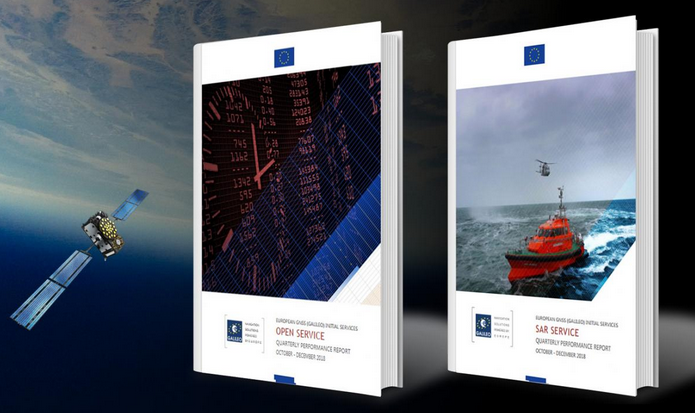Every quarter, the Galileo Service Centre publishes Performance Reports on the Galileo Open Service (OS) and Search and Rescue (SAR) Service. These reports provide the public with statistics on the delivery and quality of the Galileo Services. Users can access quantitative information on a range of parameters specific to each service. This allows them to better understand how well the Galileo services are performing, relative to minimum targets specified in the service definitions.

Galileo Initial Services were declared operational in December 2016, with the go-live of the “Open” and “Search and Rescue” Services (OS and SAR, respectively). Since then, users around the world benefit from the positioning, navigation and timing information provided by Galileo global satellite constellation. For certain categories of users, it can be important to understand how well the services are performing.
The expected performance of the services is expressed through Minimum Performance Level (MPL) targets for a number of metrics which are defined in the respective Service Definition Documents. The performance of both OS and SAR Services is continuously evaluated and published every quarter, as part of the Open Service Performance Report and the Search and Rescue Performance Report, respectively. Additional information is also provided for Services undergoing public testing; this is the case for the Open Service Navigation Message Authentication (OSNMA).
The Quarterly Reports include the characteristic features of each service, typically expressed in terms of Availability and Accuracy performance data.
The Quarterly Performance Reports contain information on:
• the parameters evaluated for each service and their meaning;
• how performance is computed and assessed;
• the Minimum Performance Level targets for each parameter;
• the most recent performance data, including corollary metrics of interest which are not subject to a specific target.
The Open Service Performance Report
The Open Service Performance Report contains quantitative measurements for the set of primary parameters which characterise this Service, namely ranging, timing, positioning, and timely publication of NAGUs (Notice Advisory to Galileo Users).
• Ranging performance is measured in terms of the accuracy of the Galileo Single/Double Frequency Ranging Service, both per individual satellite and as constellation average, and per-slot availability of healthy signals in space.
• Timing performance provides figures in terms of availability of the Galileo UTC (Coordinated Universal Time) and of Galileo‑to‑GPS Time Offset (GGTO) Determination Services. The accuracy of Galileo UTC and frequency dissemination and of GGTO determination is also included.
• Positioning performance is measured first as global feature over the Service provision area, in terms of the availability of the Position Dilution of Precision (PDOP) within an assigned threshold of 6, as well as the availability of positioning with limiting values for the maximum tolerated Horizontal and Vertical error components. Figures are also given for the Horizontal and Vertical Positioning Accuracy materially achieved at a number of sites equipped with physical reference receivers.
• The European GNSS Service Center (GSC) performance is characterised by the timely publication of NAGUs: time intervals are given, related to the advance publication of NAGUs before any planned event, as well as the time needed to publish them after any unplanned event.
The Search and Rescue Service Performance Report
The SAR Performance Report contains quantitative measurements for detection, location, and infrastructure availability for both the Forward Link and the Return Link Services.
Forward Link Service
• Detection Performance is the probability of detecting a single transmitted burst of a SAR beacon within the service area and the receipt of a valid message by dedicated ground stations known as MEOLUTs (any EU/ MEOLUT Facility).
• Location performance is computed after a single transmitted burst and after 12 transmitted bursts and is comprised of:
◦ Location Probability: the probability of having a localisation computed by the European MEOLUT for each reference beacon;
◦ Location Accuracy: measures the probability that the localisation calculated has an error (a difference between the real position and the one calculated by the MEOLUT) below a certain threshold defined in kilometres.
Return Link Service
◦ Delivery latency is the percentage of time that the service is available and transmitted within the Galileo Navigation Message in the signal-in-space (SIS) within a threshold defined in minutes.
◦ Reception probability is the probability of error-free decoding of the Return Link Message fields of the Galileo Navigation Message retrieved from the SIS at the GNSS receiver in, or connected to, the originating alert SAR beacon.
Infrastructure performance is measured in terms of the availability of SAR/Galileo Ground Segment components (MEOLUT Local Facility, MTFC, RLSP and SARN) and Space Segment (SAR Transponders), and of the availability SAR/Galileo Orbit Data Server.
Interested readers are encouraged to explore these documents and the Service Definition Documents for a complete description of how these parameters are measured, the values of the Minimum Performance Level defined for each of them, and how the performance for OS and SAR Services has evolved.
Check the last OS and SAR performance via the following link:
https://www.gsc-europa.eu/electronic-library/performance-reports
Read the Service Definition Documents here:
https://www.gsc-europa.eu/electronic-library/programme-reference-documents
Media note: This feature can be republished without charge provided the European Union Agency for the Space Programme (EUSPA) is acknowledged as the source at the top or the bottom of the story. You must request permission before you use any of the photographs on the site. If you republish, we would be grateful if you could link back to the EUSPA website (http://www.euspa.europa.eu).